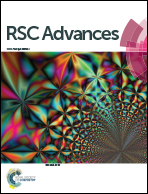Improving the photocurrent of a PBDTTT-CF and PCBM based organic thin film photoconductor by forming a bilayer structure
Abstract
The performance of traditional organic thin film photoconductors (OTFPs) is limited by the low carrier mobility in the donor : acceptor (D : A) blend film. To overcome such a problem, a higher-mobility carrier transport layer should be included in the D : A blend based device. However doing so will certainly result in a bilayer or even multilayer structure, which is usually a challenge for all-solution processing methods. Here by carefully controlling and adjusting the fabrication process, an all-solution-processed PBDTTT-CF/PBDTTT-CF : PCBM bilayer OTFP is demonstrated. In such a bilayer device, the PBDTTT-CF : PCBM blend layer is responsible for light absorption and free photo carrier generation, and the underlying PBDTTT-CF layer is responsible for the photo carrier transport inside the device. The hole mobility in the PBDTTT-CF layer is measured to be 9.1 × 10−4 cm2 V−1 s−1, much higher than that in the PBDTTT-CF : PCBM blend film, which is only 4.3 × 10−5 cm2 V−1 s−1. As a result of the faster carrier transport, the bilayer device exhibits a greatly enhanced photocurrent, which is about 7 times higher than that of the single blend layer device. Meanwhile, the on/off response of the bilayer device is also improved, which is shorter than 0.1/0.1 s.


 Please wait while we load your content...
Please wait while we load your content...